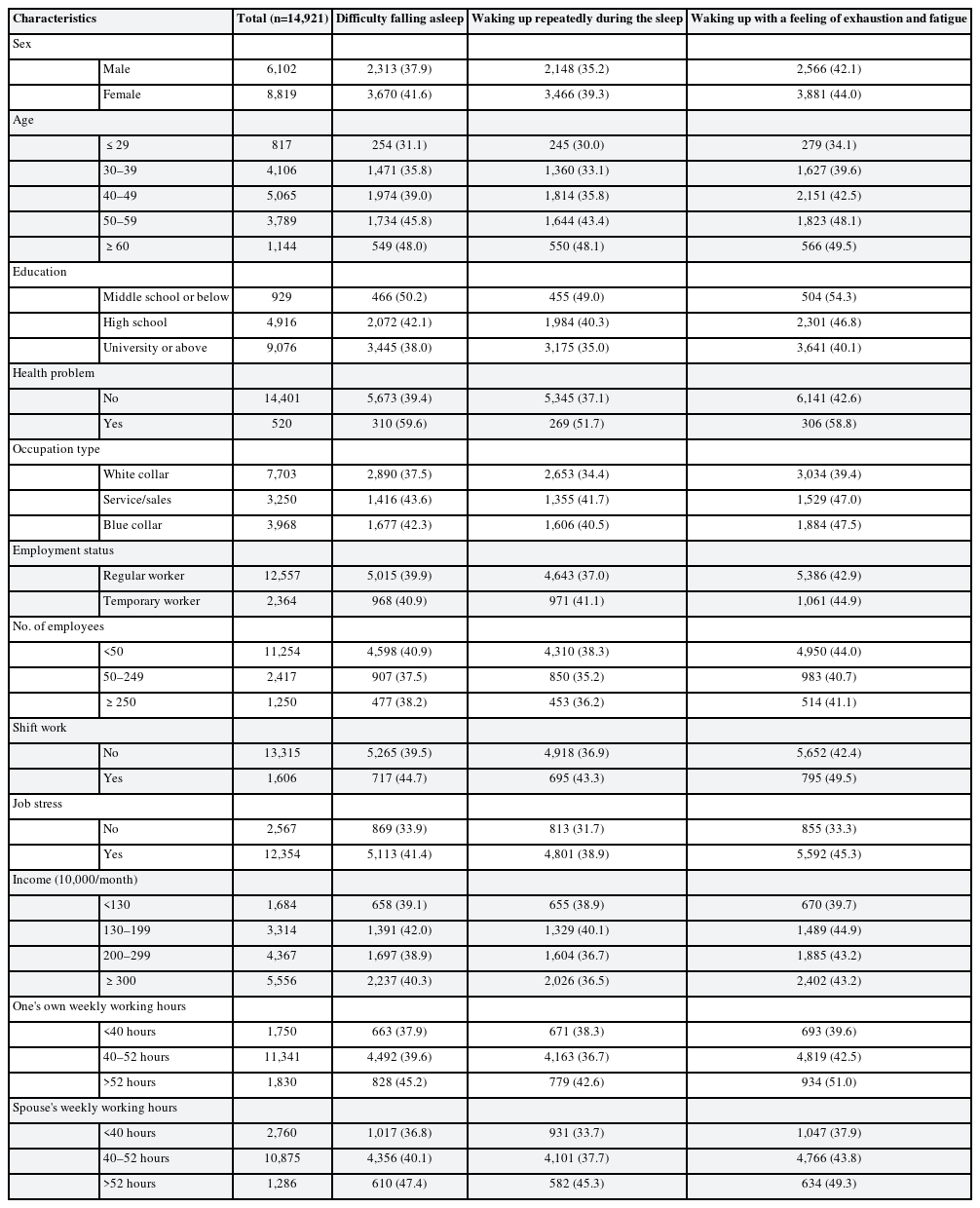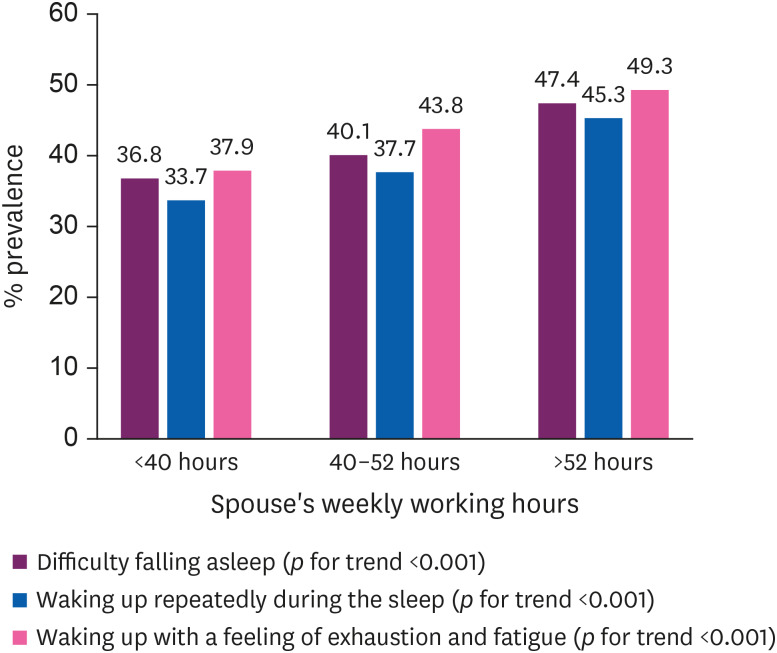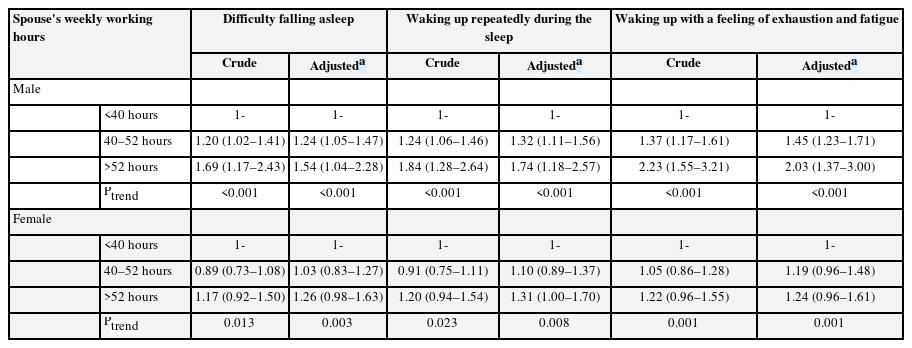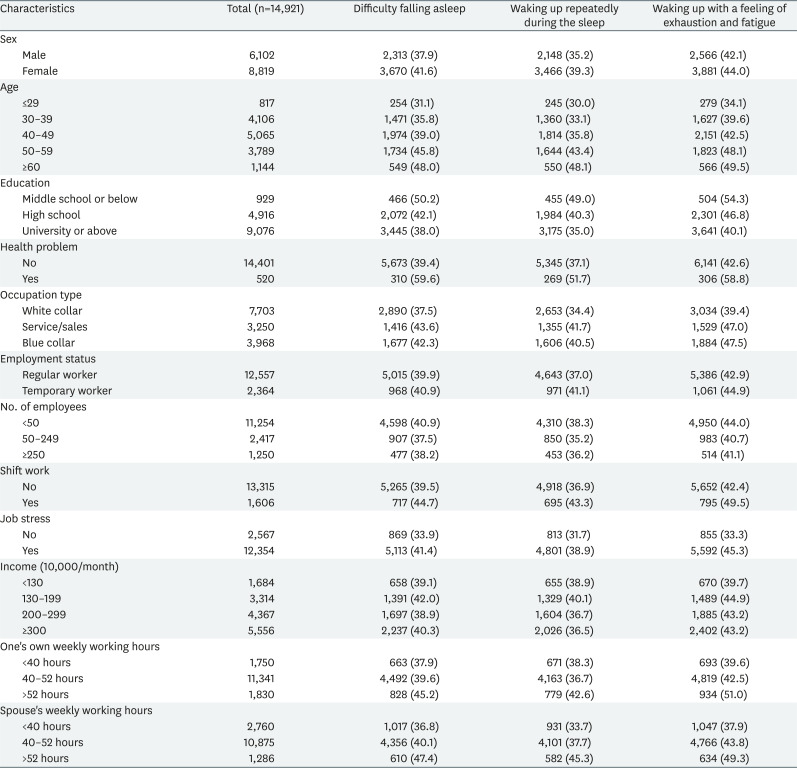Relationship of spouses' weekly working hours and sleep problems in Korean wage workers: the 5th Korean working conditions survey
Article information
Abstract
Background
Sleep disorders are common and serious problems for mental health. This study investigated the relationship between spouses' weekly working hours (SWWH) and sleep problems by using the data from the 5th Korean Working Conditions Survey.
Methods
Data from 14,921 wage workers were used in the 5th Korean Working Conditions Survey. General and occupational characteristics, sleep problems are included in the questionnaire. Multivariate logistic regression analysis was used after adjustment for general and occupational characteristics to find the relationship between SWWH and sleep problems.
Results
Compared to those whose spouses worked less than 40 hours per week, risk of trouble falling asleep, waking up repeatedly while sleeping, and waking up with a feeling of exhaustion and fatigue was significantly higher as SWWH increase among those whose spouses worked 53 or more hours per week (odds ratio [OR]: 1.40, 95% confidence interval [CI]: 1.16–1.70; OR: 1.50, 95% CI: 1.23–1.82; OR: 1.51, 95% CI: 1.24–1.83).
Conclusions
SWWH were related to sleep problems among Korean wage workers.
BACKGROUND
Insomnia is a common clinical disorder characterized by difficulties in initiating or sustaining sleep, followed by symptoms such as irritability or fatigue during wakefulness. The prevalence of insomnia is about 10-20%, with approximately 50% having a chronic course [1]. The Organisation for Economic Cooperation and Development (OECD)'s latest sleep study shows that Korea was the second lowest in terms of the amount of sleep out of 33 surveyed countries [2].
Increasing age, female sex, comorbid (medical, mental, sleep, and substance use) disorders, shift work, and unemployment and lower socioeconomic status are consistent risk factors for insomnia [3456]. There has also been a spouse study of sleep problems. Ulfberg and colleagues [7] compared wives of heavy snorers with those of non-snorers and found more frequent reports of insomnia, morning headache, daytime sleepiness, and fatigue among the former.
According to Statistics Korea, there were 5.68 million dual-income households in 2018, up 4% or 219,000, from 5.45 million reported in 2017 [8]. As a result of multiple challenging roles, the most common stresses for dual-career partners, who are also children's mothers and fathers, include overload and role conflict [9]. Conflict between work and family can lead to psychological strain, reduced job satisfaction, reduced family satisfaction, and decreased marital satisfaction [10].
There is enough evidence to prove the relationship between the incidence of mental and physical health problems and the working hours of the person [1112]. However, few studies have focused on the potential effect of working hours on the spouse, the person most frequently interacting with the worker [1314]. A large number of occupational psychology studies have shown that poor working conditions can exacerbate employees' family life [15]. In addition, stress and strain in the workplace have been reported not only to affect the individual's own health but also to be transmitted to their partners, both in terms of mental and physical health [15]. To the degree that we know, there is no direct evidence to support the theory that working overtime may affect the sleep problem of a spouse.
This study aims to investigate the association between spouse's long working hours and sleep problems using representative data from a national, population-based survey.
METHODS
Study subjects
This study used data from the ‘Fifth Korean Working Conditions Survey (KWCS)’ carried out by the Occupational Safety and Health Research Institute (OSHRI) in 2017. This survey was built on the basis of the European Working Conditions Survey carried out throughout Europe. The survey carried out door-to-door interviews with wage workers aged 15 years and older; as a result, 50,205 people were surveyed for the KWCS. Since this study focused on the effect of spouse's working hours on sleep problems, subjects without spouses were excluded (n=26,531). Respondents who gave insufficient answers, such as ‘do not know’, or those who either did not or refused to respond were exempted (n=2,438). Since wage workers were the target population, self-employed workers, employers, unpaid family/household members, and other workers were excluded (n=6,247). It also excluded the low number of occupational category respondents serving in the military or working as agriculture, forestry and fishery workers (n=68). In total, 14,921 workers became the sample of the survey.
Variables
General and occupational characteristics
General characteristics included gender, age (<30, 30–39, 40–49, 50–59, and ≥60 years), educational level (middle school or below, high school graduate, and university graduate and above), and health problem. Health problem was evaluated by the question, “Do you have any illness or health problem which has lasted, or is expected to last, for more than 6 months?” with 2 response options: yes and no.
Occupational characteristics included employment status (regular workers, and temporary workers/day laborers), type of occupation (white collar workers, service/sales worker, and blue collar workers), one's own weekly work hours (<40, 40–52, and >52), shift work flexibility, size of workplace (<50, 50–249, and ≥250), job stress, and monthly income (<1,300,000, 1,300,000–1,990,000, 2,000,000–2,990,000, and ≥3,000,000 Korean won [KRW]). Managers, professionals and related workers, and office workers were classified as white-collar workers, service workers and sales workers were classified as service/sales workers, and technicians and related technical workers, equipment and machinery operation and assembly workers, and simple laborers were classified as blue-collar workers. Job stress was evaluated by the question, “Do you experience stress in your work?” with 5 response options: always, most of the time, sometimes, rarely, and never. Job stress was classified into the following 2 groups: yes (always, most of the time, or sometimes) and no (rarely or never).
Spouses' weekly working hours
Spouses' weekly working hours were assessed by the question, “You said your spouse lives in the household. How many hours do your spouse usually work a week, including paid or unpaid overtime?” Working hours per week shall not exceed 40 hours, except break times, in compliance with the Korean Labor Standards Act. When an agreement is reached between the parties concerned, the working hours may be extended up to 12 hours a week [16]. Therefore, we categorized spouses' weekly working hours were classified into the following 3 groups: <40 hours, 40–52 hours, and >52 hours.
Sleep problems
Sleep problems were self-assessed: subjects were asked, “During the past 12 months, how often would you say you have had any of these problems related to your sleep?” The 3 problems included difficulty falling asleep, waking up repeatedly during the sleep, and waking up with a feeling of exhaustion and fatigue. Response sets for the frequency of each problem were daily, several times a week, several times a month, less often and none. These responses were classified into the following 2 groups: yes (daily, several times a week, several times a month, less often) and no (none).
Data analysis
The final data analysis was performed by applying the weights presented in the dataset under the KWCS data usage manual. The chi-square test was used to assess the distribution according to their general and occupational characteristics of the workers with sleep problems. Next, the study attempted to analyze the relationship between spouses' weekly working hours (SWWH) as independent variables and sleep problems as dependent variables. Multivariate logistic regression analysis was carried out by adjusting general and occupational characteristics. For the linear trends, the number of levels for SWWH was used as a continuous variable and tested on each model. The significance level was 0.05. The variance inflation factor (VIF) value was calculated to determine the multicollinearity among variables used in this study. Additionally, we stratified the participants by sex for analysis. All statistical analyses were performed using the SPSS software (version 25.0; IBM Corp., Armonk, NY, USA).
Ethics statement
This study was approved by the Institutional Review Board (IRB) of Soonchunhyang University Cheonan Hospital (IRB No. 2020-05-016).
RESULTS
Distribution of sleep problems according to general and occupational characteristics
Women had a higher percentage of difficulty falling asleep (41.6%), waking up repeatedly during the sleep (39.3%), and waking up with a feeling of exhaustion and fatigue (44.0%) than men did. When age increased, the chances of each sleep problem became higher. Lower education levels also showed higher chances of having problems with sleep. Each sleep problem rate was higher in workers who had any health problem. In terms of types of occupations, service/sales workers and blue-collar workers had a higher proportion of sleep problems than white-collar workers. With regard to employment status, the proportion of non-regular workers was significantly higher than that of regular workers in waking up repeatedly during the sleep (40.9%), but there was no significant difference between the two groups over other sleeping problems. Each sleep problem rate was the highest in small businesses (<50 employees) in terms of workplace size. All sleep problem rate was higher in shift work (44.7%, 43.3%, and 49.5%), and workers who experienced stress in their work (41.4%, 38.9%, and 45.3%). In terms of income level, the rate of each sleep problem was the highest in workers whose monthly income was 1,300,000 to 1,990,000 KRW. The highest proportion of sleep problems was observed in the group whose weekly working hours are more than 53 hours (Table 1).
Linear relationship between SWWH and sleep problems
The proportion of each sleep symptom (difficulty falling asleep, waking up repeatedly during the sleep, and waking up with a feeling of exhaustion and fatigue) was greatest in the 53 hours or more SWWH (47.4%, 45.3%, and 49.3%, respectively). With an increase in SWWH, the proportion of all these symptoms of sleep increased (p-values for all the trends were below 0.001) (Fig. 1).
Odds ratios (ORs) with 95% confidence interval (CI) of sleep problems
The OR (95% CI) for each sleep problem was 1.55 (1.30–1.85), 1.63 (1.36–1.94), and 1.59 (1.34–1.90) in the 53 or more SWWH group, as compared to whose spouse worked less than 40 hours. Adjustment for sex, age, education, health problem, occupation type, employment status, number of employees, shift work, job stress, monthly income and participant's weekly working hours did not attenuate this association (OR: 1.40, 95% CI: 1.16–1.70; OR: 1.50, 95% CI: 1.23–1.82; OR: 1.51, 95% CI: 1.24–1.83, respectively). The ORs increased with an increase in SWWH, and the p-value for this trend was below 0.001 in the adjusted model (Table 2). Of most variables, the VIF value was nearly 1. The highest VIF value was 1.97 for education, so we concluded that there is little multicollinearity among variables.
Tables 3 lists the results of multivariate logistic regression analyses in men and women, respectively. SWWH was significantly associated with the risk of sleep problems for men, but not for women.
DISCUSSION
The primary objective of this study was to investigate the relationship between SWWH and sleep-related symptoms, such as difficulty falling asleep, waking up repeatedly while sleeping, and waking up feeling tired. The results of this study showed that SWWH was significantly associated with the risk of sleep problems for individuals. These findings indicate that individual's long working hours have adverse effects not only on their own sleep health but also on their spouses' sleep health.
A plausible causal pathway between SWWH and sleep problems may be an increase in housework. Huh and Kim [17] found the most powerful factors affecting domestic work time were respondents' working time and their spouse's working time. Wives used fewer domestic work hours as their spouses worked shorter, and husbands spent more time in domestic work as their spouses worked longer in dual-income households [17]. A study on US citizens revealed that household activities were associated with sleep time [18]. The results indicated that long sleepers spent less time on household activities, whereas short sleepers spent more time in household activities [18].
Stress crossover is another possible mechanism for explaining the relationship between SWWH and sleep problems. Stress experienced in the workplace by the individual leads to stress experienced by the individual's spouse at home [19]. Long working hours are known to be associated with psychosocial stress [2021], and stress is known to be closely related to impaired sleep [22]. Taken together, someone's long working hours can lead to the spouse's sleep problems through the transmission of stress.
In terms of time-sharing among spouses, the amount of time shared with dual-earner couples is limited by the number of hours they have worked [23]. A study on Korean couples revealed that the husband and wife's satisfaction with dual-income households increased as housework hours with spouses increased, and the satisfaction of the dual-income wife may also increase as the spouses spend their leisure time with their spouses [24]. In a few cross-sectional and longitudinal studies, associations between decreased life satisfaction and poor or inadequate sleep have been identified [252627].
In Table 3, SWWH was significantly associated with the risk of sleep problems for men, but not for women. According to a report by Korea Institute for Health and Social Affairs, working hours for both men and women have gradually decreased, and men are still spending the most time on work, and women have been found to spend considerable time on household chores and childcare [28]. These differences in our study can be said to reflect the special situation of Korea.
This study has several limitations. First, our study's cross-sectional design did not allow us to draw conclusions about the causality between SWWH and sleep problems. Longitudinal data analysis would allow further investigation of the questions raised by this study. Second, the KWCS omitted general characteristics such as medical history, drinking, smoking, and other variables that may affect sleep from the questionnaire items and these were not included in the adjustment. Finally, while our study showed an association between SWWH and sleep symptoms, the mechanisms behind our results are not being clearly examined.
One strength of this research is that this was the first time to figure out the relationship between spouse's weekly working hours and sleep problems using the data from KWCS. There were many studies on long working hours associated with sleep problems. However, our study is the first research to find out how spouse's long working hours affect the sleep health of workers in the Republic of Korea.
CONCLUSIONS
In conclusion, our research has shown associations between long working hours and the sleep problems of the partner. The results of this study suggest that shortening working hours can help reduce the spouses' sleep problems. Therefore, subsequent studies are needed to figure out the causes leading to these results.
Acknowledgements
I would like to thank Safety and Health Policy Research Department (Occupational Safety and Health Research Institute) for offering raw-data of Korean Working Conditions Survey (KWCS). The paper's contents are solely the responsibility of the author and do not necessarily represent the official views of the OSHRI.
Notes
Competing interests: The authors declare that they have no competing interests.
Availability of data and materials: Data sharing not applicable to this article as no datasets were generated or analyzed during the current study.
Author Contributions:
Conceptualization: Park C, Jang EC.
Data curation: Park C, Chai SR.
Formal analysis: Park C, Jang EC, Min YS.
Investigation: Park C, Jang EC, Min YS.
Validation: Jang EC, Lee YJ, Kwon SC, Min YS.
Writing - original draft: Park C.
Writing - review & editing: Jang EC, Min YS.
Abbreviations
CI
confidence interval
KRW
Korean won
KWCS
Korean Working Conditions Survey
OECD
Organisation for Economic Cooperation and Development
OR
odds ratio
OSHRI
Occupational Safety and Health Research Institute
SWWH
spouse's weekly working hours
VIF
variance inflation factor







